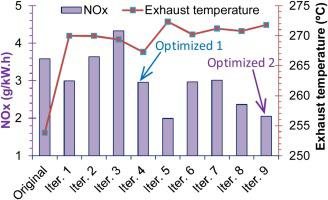Chemical Engineering and Processing: Process Intensification ( IF 3.8 ) Pub Date : 2020-09-06 , DOI: 10.1016/j.cep.2020.108132 Di Wu , Banglin Deng , Meng Li , Jianqin Fu , Kaihong Hou

|
Heavy duty diesel engines emit over half of mobile source NOx, so SCR is used to reduce NOx. But in applications, SCR is hard to work in desired temperature range. In this work, we try to improve exhaust thermal management and finally reduce NOx through intake throttling effect. Firstly a throttle was designed and its response characteristics were widely explored through steady-state experiment. Results showed that exhaust temperature can be raised largely through intake throttling degree (TD) control, it has obvious effect only after 60 % TD. At 1100 r/min and 65 % TD, exhaust temperature rises by 123.3 °C, 74.2 °C, 49.7 °C and 33.5 °C for 600 N·m, 400 N·m, 200 N·m, and 50 N·m loads, respectively. TD demand for rising transition point becomes larger as engine load decreases, at 600 N·m transition point occurs at 61 % TD, but it increases to 68 % TD at 50 N·m. Finally the intake flow rate was optimized continuously with whole cycle level consideration in transient operation. NOx decreased by 43 % with fuel consumption and HC keeping unchanged, while CO increased by 24.6 %. We hope to provide a good example for diesel engine performance improvement from optimization of existing technologies without too much cost.
中文翻译:

通过节流度优化改善重型柴油机的性能和排放:稳态和瞬态实验研究
重型柴油机排放的移动源NOx超过一半,因此使用SCR还原NOx。但是在应用中,SCR很难在所需的温度范围内工作。在这项工作中,我们尝试改善排气热管理,并最终通过进气节流效应减少NOx。首先设计了一种节气门,并通过稳态实验对其响应特性进行了广泛探索。结果表明,通过控制进气节流度可以大大提高排气温度,只有在TD达到60%时,排气温度才有明显的提高。在1100 r / min和TD为65%的情况下,600 N·m,400 N·m,200 N·m和50 N·m的排气温度分别升高123.3°C,74.2°C,49.7°C和33.5°C。分别加载。随着发动机负荷的降低,对上升过渡点的TD需求变得更大,在600 N·m的过渡点上,TD为61%,但在50 N·m时,TD增加到68%。最终,在瞬态运行中考虑了整个循环水平,对进气流量进行了连续优化。在燃油消耗和HC保持不变的情况下,NOx减少了43%,而CO则增加了24.6%。我们希望为通过优化现有技术而无需花费太多成本来改善柴油机性能提供一个很好的例子。











































 京公网安备 11010802027423号
京公网安备 11010802027423号